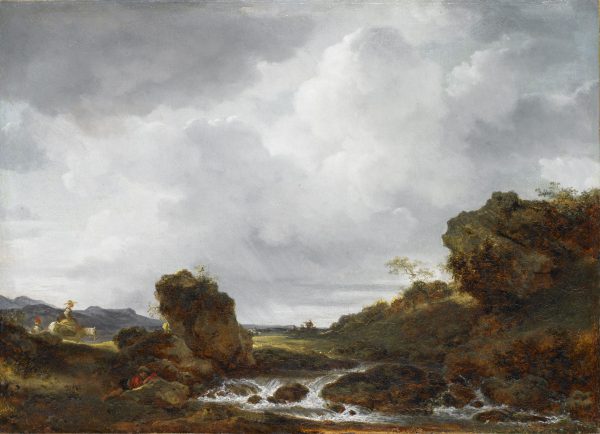The Torrent, Ca. 1763-1765.
Oil on paper laid down on canvas., H. 0.27 m; W. 0.37 m
Provenance: Private American collection from 1933
Parke Bernet sale, New York, January 28, 1953, n° 34
Sotheby’s Parke Bernet, New York, June 11, 1981, n° 37
Galerie Lida, Tokyo, 1988, n° 24
Private collection.
- Baron de Portalis, Jean Honoré Fragonard, sa vie, son œuvre, Paris, 1889, p. 290.
- P. de Nolhac, J.H. Fragonard, Paris, 1906, p.136 .
- L. Réau, Fragonard, sa vie, son œuvre, Bruxelles, 1956, p. 185 .
- J.P Cuzin, Jean-Honoré Fragonard, vie et œuvre, Fribourg, 1987, p. 280, n° 113.
- P. Rosenberg, Tout l’œuvre peint de Fragonard, Paris, 1989, p. 86, n° 134 (ill.).
Fragonard was a pupil of Jean Siméon Chardin and François Boucher. He obtained the Prix de Rome in 1752 and worked under Carle Vanloo in the Ecole royale des élèves protégés for three years. From 1756 to 1761 he studied at French Academy in Rome, at this time directed by Natoire who encouraged his pupils to work out of doors and draw landscapes. In Rome Fragonard became a close friend of Hubert Robert and the Abbé de Saint-Non. Fragonard and Robert worked a lot together in the country side and influenced each other profoundly in style. During the summer of 1760 a visit to the villa d’Este at Tivoli was going to have a decisive impact on Fragonard’s artistic career.
On his return to Paris in 1761, Fragonard undertook a series of landscapes close in style to Dutch 17th century painting. The Torrent reveals a direct influence of Dutch 17th century landscapes on the aesthetics of that time. Fragonard’s admiration for Jacob van Ruisdael, whose influence is evident in the present picture, was already brought to light. With great subtlety Fragonard shows condensed and sometimes threatening clouds that find an echo with the rough terrain and the silhouettes of trees. The blue and silvery sky takes up three quarters of the composition. The artist adds rural figures, often heightened with lively red, and also animals. Far from a simple imitation, Fragonard reinterprets the style of his predecessors according to his eighteenth century sensibility. Whether or not Fragonard actually ever travelled to Holland remains uncertain. However, he could easily have studied Dutch 17th century landscapes in private collections in Paris.



